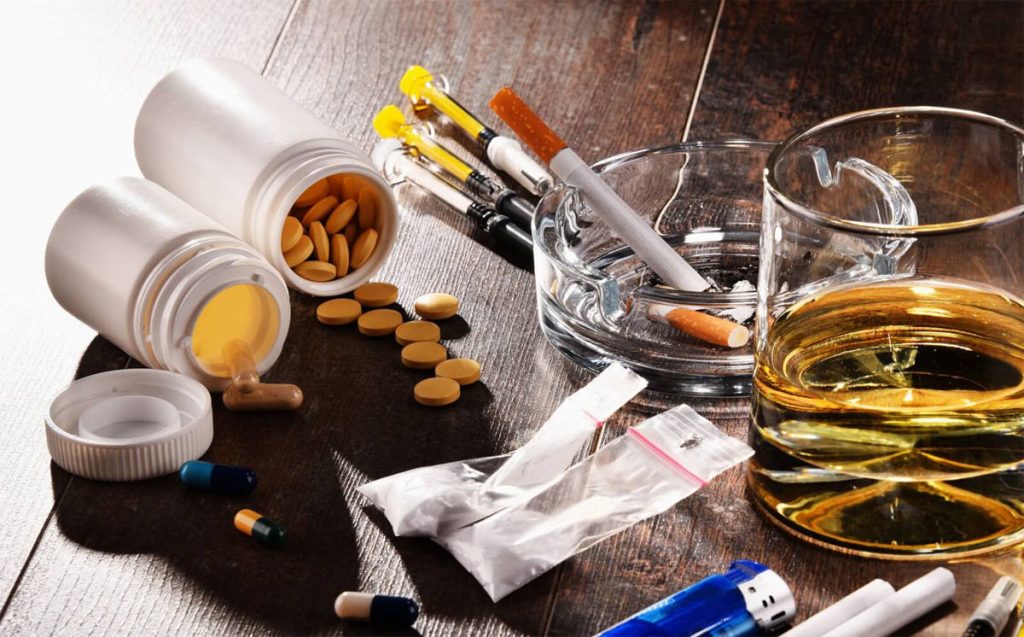
Sanjoo Thangjam
Chemically dependent person may exhibit many signs and symptoms in a variety of combinations. The problems or damages which may follow also occur in diverse combinations. The degree to which the dependency is developed also varies widely.
The term addiction has been used to refer to both addiction to alcohol and other drugs. However, several aspects of alcoholism and drug addiction and their manifestations are written separately.
1. What are the characteristics of addiction?
The characteristics of addiction are as follows:
It is a primary disease:
As it has been established that addiction per se is a disease which causes mental, physical and spiritual problems. These associated problems can’t be effectively dealt with unless addiction is treated first.
It is a progressive disease:
If it is not treated, the disease progresses from bad to worse. Sometimes there may be occasional or intermittent periods where one feels that there is improvement, but over a period of time, the course of disease will only be towards deterioration.
It will be a terminal disease:
A person taking drugs or drinking alcohol excessively, may die due to some medical complications. But on close observation, it will be found that the complication itself was induced by drugs or alcohol. Thus, drug or alcohol is the real agent behind the person’s death.
It is incurable but treatable/arrestable:
The disease of addiction is incurable but it can be successfully arrested or rather treated with the help of timely, appropriate and comprehensive treatment. Treatment aims at total abstinence from drugs or alcohol.
Total abstinence means staying away from drugs/alcohol totally for life. Ingestion of even a very small amount of alcohol or drugs will lead the person to obsessive drinking or drug taking within a few days and he will lose control.
In other words, an addict or a chemical dependent person can never go back to drinking or drug taking again, even if he/she remained sober or clean for quite a number of years. Hence, addiction is considered a permanent disease.
2. What are the phases of alcoholism ?
There are three distinctly noticeable phases in the disease of alcoholism.
Early phase:
Increased tolerance: This is the first warning sign of the development of alcoholism. It is the body’s ability to overcome the usual effect of a drug so that an increased dosage is needed to experience the same effect as before.
Black out: This is a period of temporary amnesia which occurs during the drinking days. This is not ‘falling flat’ or unconsciousness, however during black out, the person may go through many activities, without being able to remember even a trace of them later on.
Preoccupation with drinking: Even when the alcoholic is not drinking, he is always pre-occupied with thoughts of how, when and where he could get the next drink.
Avoiding any talk about alcohol: When anyone talks about alcohol, the alcoholic moves away feeling guilty about his drinking.
Middle Phase:
Loss of control: Earlier, there is loss of control over the amount of alcohol consumed. Later on, the alcoholic loses control over the quantity, time, place and occasion of drinking.
Justifying his drinking (denial): The alcoholic feels guilty and depressed, and so as to reduce such feelings, he develops an elaborate defence system of reasons and excuses for his drinking.
Grandiosity: This is the time where the alcoholic exhibits grandiose behaviour which is inconsistent with his financial and professional capabilities. e.g. spends much more than that he can afford, talks ‘Big’ about himself.
Abstaining from alcohol for a temporary period: At this stage, he stops taking alcohol for some days to prove he has control over himself. But soon goes back to drinking.
Changing the drinking pattern: This is another precaution that the alcoholic tries, he changes his friends, the time and place of taking alcohol. An attempt towards self-control, but none of this works and helps so he again continues and goes back to drinking.
Chronic phase:
This phase is characteristic by noticeable physical, mental and social deterioration (Spiritual bankruptcy).
Binge drinking: The alcoholic drinks continuously for days together without caring for anyone or anything.
Ethical breakdown : The alcoholic steals, lies or goes to any extent to buy alcohol in order to maintain his daily supply of alcohol.
Paranoia: The alcoholic becomes suspicious of everyone, thus becoming a victim of circumstances.
Hallucinosis: The alcoholic experiences hallucination. They may be auditory (imaging voice speaking), visual (seeing non-existent things) and tactile (feeling as though something is crawling on the skin).
Lack of motor co-ordination: This is the stage where the alcoholic experience shakes and tremors though not for the first time. Previously, he could control them by taking more alcohol, now they are more pronounced and alcohol does not help in ‘quietening’ them.
Turning to God: Becomes desperate and turns to God for help to maintain a supply of alcohol to manage his drinking. The alcoholic pleaded with God not to remove his desire for alcohol. This is the final stage when the vicious cycle begins.
He drinks just for the sake of drinking, drinks only to stay alive. When the alcoholic reaches this stage, two things may happen to him. He either continues to take alcohol and becomes mentally ill or he continues drinking and dies a premature, painful death.
The only solution to this problem is to stop drinking totally for life.
What are the phases of addiction to drugs (Drug Addiction)?
Just like ‘Alcoholism’, dependency on any other drug is also a disease – a primary, progressive, yet treatable disease. Here also abstinence is the one and only solution to the problem. The disease is progressive and goes through defined stages as in the case of alcoholism.
Early stage:
– Quantity of drug intake increases and doses are taken more frequently. Increasingly, more time is spent using the drugs and on being in the intoxicated state.
– Alters situations to facilitate increased use of drugs
– reduces time and money, spent on other non-drug behaviour. e.g. cuts down money spent in the other activities to ensure sufficient money for the drug.
-Thoughts and conversation centre often around drugs. Thinks about when he can use the drug. From whom he can get or how he is going to pay at a lower price.
– Rationalises his use of drug. May tell himself that drugs are not dangerous to use and ‘drug warning’ are not based on facts.
Middle Stage:
– Tolerance for the drug increases dramatically.
– Addiction develops-he needs the drug to ensure a sense of well being and later on, to avoid withdrawal.
– Is unable to limit drug use. Frequently, loses control over the occasions when he uses drugs.
– Resolves often to stop drug use, but his repeated efforts only fail. Substitute drugs are tried.
– Maintains hidden supply of the drugs because the very thought about its absence is threatening.
– Begins to have problems at school, college and place of work.
– Uses drugs to handle unpleasant emotional state and sometime uses them when he anticipates problems.
– Family relationship becomes strained-neglects responsibilities; is not dependable.
– Personality shifts are observable.
– Alienation from friends who were close to him prior to drug use. Interest in extra-curricular/leisure activities decline considerably.
– Neglect of personal hygiene-poor grooming and poor eating habits.
– Feeling of anxiety, guilt or shame may strengthen.
Advanced stage:
– Drug use turns continuous
– Loss of control over the drug is complete. Experience less and less pleasure from the drug but continue using it to avoid withdrawal symptoms.
– Cheaper drugs are used when the drug of choices cannot be obtained.
– Becomes increasingly dependent on other people to carry on the pretext of living. He often eats only because is pressurised.
-Social relationship are almost non-existent and companionship is limited almost exclusively to drug addicts.
– Persons may leave home and start living alone.
– Many face premature death due to poor health condition.
Chemically dependent person may exhibit many or most of the signs and symptoms listed above in a variety of combinations. The problems or damages which may follow also occur in diverse combinations. The degree to which the dependency is developed also varies widely.
So it is the responsibility of those people working in the field of addiction and the general public as well, not to simply label the person as an addict but rather to specify what signs and symptoms support such diagnosis. {The writer is a Sub-Editor of The Morning Bell & Social Activist of People Who Use Drugs (PUDs)}





